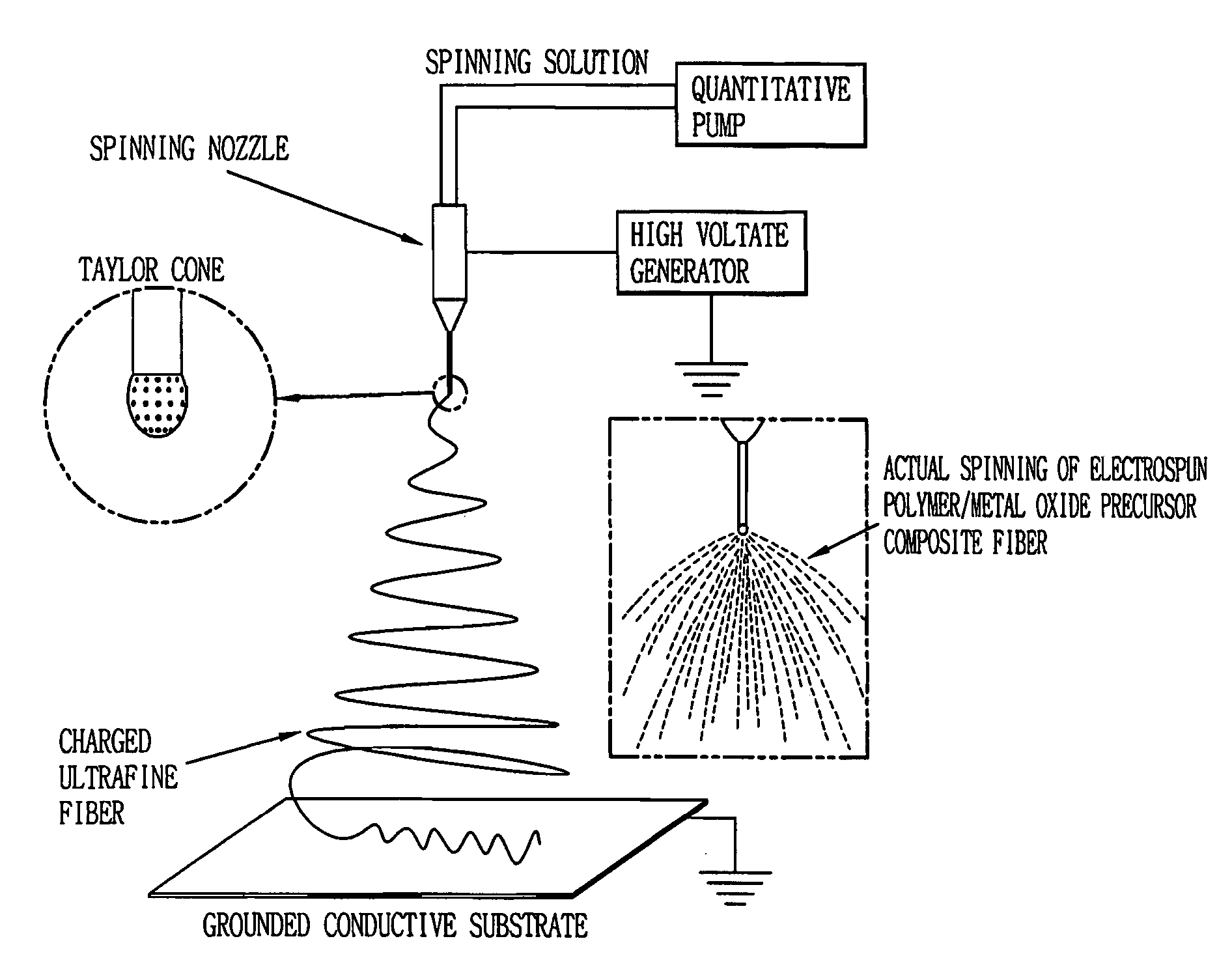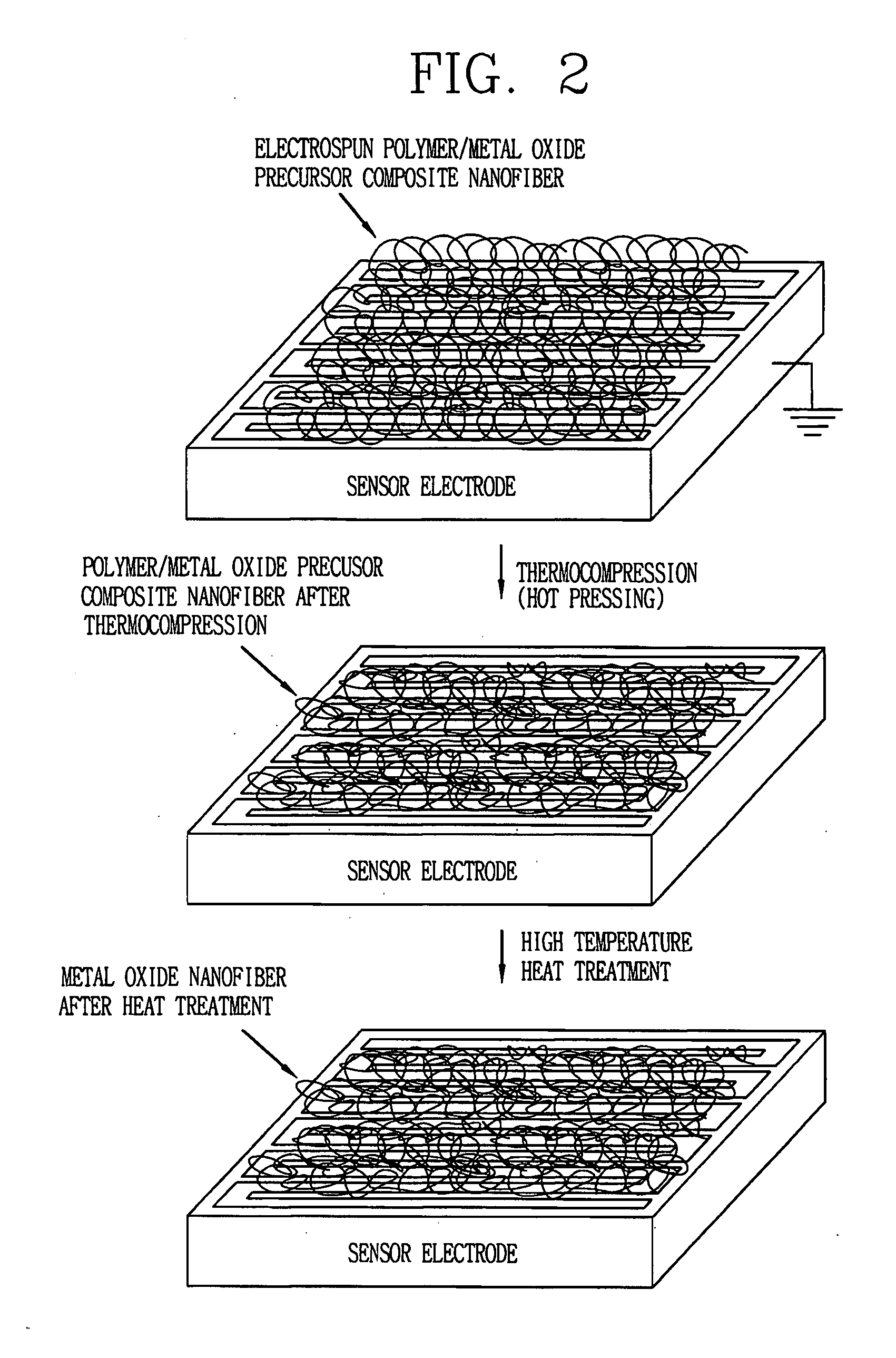Ultra-sensitive metal oxide gas sensor and fabrication method thereof
a gas sensor and ultra-sensitive technology, applied in the field of ultra-sensitive metal oxide gas sensors, can solve the problems of deficient sensitivity and difficulty in fabricating devices having high reproducibility, and achieve the effects of excellent gas diffusivity, fast response time, and increased specific surface area
- Summary
- Abstract
- Description
- Claims
- Application Information
AI Technical Summary
Benefits of technology
Problems solved by technology
Method used
Image
Examples
comparable example 1
Thermal Treatment without Thermocompression after Electrospinning of a Mixture Solution of Polyvinyl Acetate and TiO2 Precursor
[0068] Titanium propoxide of 6 g was slowly added at the normal temperature to a polymer solution prepared by dissolving polyvinyl acetate (Mw: 850,000) of 30 g in a mixed solvent of acetone of 270 ml and dimethylformamide of 30 ml. With the reaction by moisture of the solvent, the resulting solution became a suspension. Acetic acid of 2.4 g was slowly dropped as a reaction catalyst. With the reaction, the suspension became a transparent solution.
[0069] The electrospinning was carried out by using the electrospinning device of FIG. 1. The Pt-coated Al2O3 substrate was used as a cathode, and the metal needle connected to the pump controlling the discharge speed was used as an anode. Voltage of 15 kV was applied between the two electrodes. The discharge speed of the spinning solution was controlled to 30 μl / minute. The electrospinning was performed until the...
comparable example 2
Thermal Treatment without Thermocompression after Electrospinning of a Mixture Solution of Polyvinyl Acetate and ZnO Precursor
[0071] A polymer solution obtained by dissolving polyvinyl acetate (Mw: 1,000,000) of 2.4 g in dimethylformamide of 15 ml for one day is mixed with a solution obtained by dissolving zinc acetate of 6 g in dimethylformamide of 15 ml. At this time, acetic acid of 2 g is reacted as a catalyst for the sol-gel reaction while being stirred for two hours. The precursor in which the reaction has been made is transferred into syringe and mounted on the electrospinning device. Afterwards, a voltage is applied between a tip provided in the end of the syringe and the substrate (in this case, sensor electrode) to obtain an ultrafine ZnO-polyvinylacetate composite fiber layer (see FIG. 12a). In this case, the voltage is 15 kv, the flow rate is 15 μl / min, the total discharge amount is 500 to 5,000 μl, and the distance between the tip and the substrate is 10 cm. Especially,...
comparable example 3
Thermal Treatment without Thermocompression after Electrospinning of a Mixture Solution of Polyvinyl Acetate and SnO2 Precursor
[0073] A polymer solution obtained by dissolving polyvinyl acetate (Mw: 1,000,000) of 2.4 g in dimethylformamide of 15 ml for one day is mixed with a solution obtained by dissolving tin acetate of 6 g in dimethylformamide of 15 ml. At this time, the solution is transparent and has a little yellow color. Then, acetic acid of 2 g is reacted as a catalyst for the sol-gel reaction while being stirred for two hours. The transparent precursor in which the reaction has been made is transferred into a syringe and mounted on the electrospinning device. Afterwards, a voltage is applied between a tip provided in the end of the syringe and the substrate to obtain a SnO2-polyvinylacetate composite fiber layer (see FIG. 17a). In this case, the voltage is 12 kv, the flow rate is 30 μl / min, the total discharge amount is 500 to 5,000 μl, and the distance between the tip and...
PUM
 Login to View More
Login to View More Abstract
Description
Claims
Application Information
 Login to View More
Login to View More - R&D
- Intellectual Property
- Life Sciences
- Materials
- Tech Scout
- Unparalleled Data Quality
- Higher Quality Content
- 60% Fewer Hallucinations
Browse by: Latest US Patents, China's latest patents, Technical Efficacy Thesaurus, Application Domain, Technology Topic, Popular Technical Reports.
© 2025 PatSnap. All rights reserved.Legal|Privacy policy|Modern Slavery Act Transparency Statement|Sitemap|About US| Contact US: help@patsnap.com



